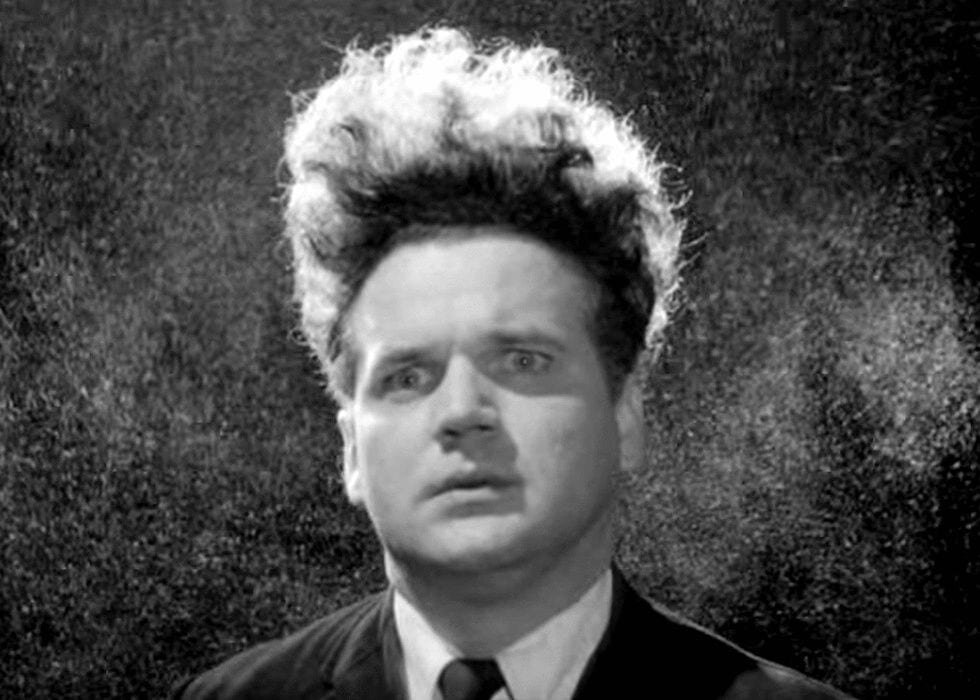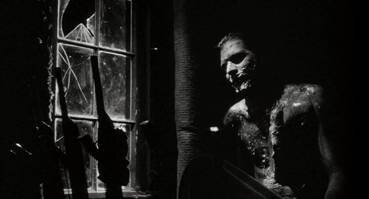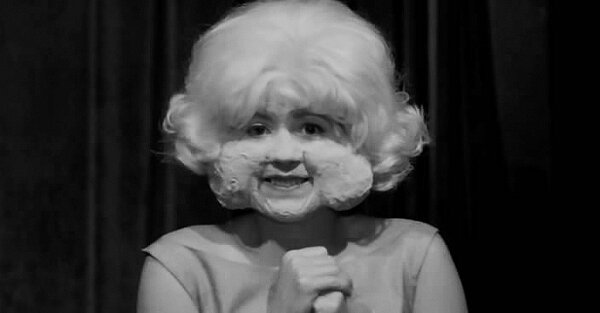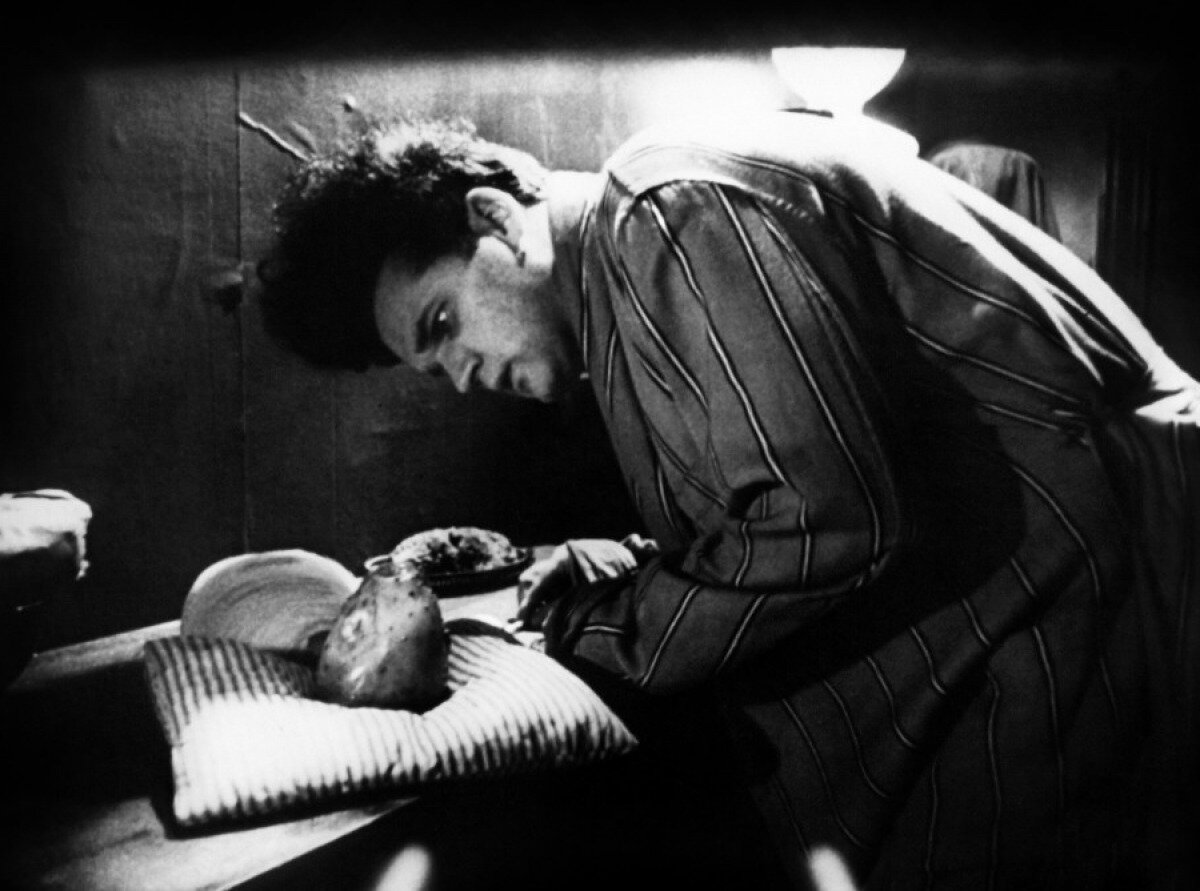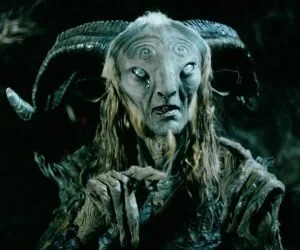Henry Spencer's Nightmare of Fatherhood in Eraserhead
BEWARE SPOILERS
We go into every post assuming you’ve already watched the film being discussed.
Eraserhead (1977) is available on HBO Max as of this writing (5/30/2021).
Last week, we mentioned off-handedly that, in David Lynch’s films, “the difference between reality and dream doesn’t matter--it’s all real, normal, silly, dreamy, nightmarish.” Nowhere is that more true than in his first feature, 1977’s Eraserhead.
Unlike most dreamscapes in story-driven media, which offer some kind of break from the weird--some grounding in reality--Eraserhead is relentless in its dedication to the absurd, the surreal, the uncomfortable.
Even when we get something almost like reality, it’s wrapped in a score and sound design (mostly composed by Lynch himself) that make even the ordinary horrifying. And those brief moments of something-almost-like-reality are quickly warped by disturbing images and an approach to dialogue that straddles the line between formal and frothing-at-the-mouth insane.
In short, Eraserhead is among the most fully-realized dreamscape films I’ve ever seen. If you’re not a fan, I get it. The movie’s gross, unsettling, and hard to follow. That’s fair. You can not like it for those reasons.
But you might have this idea that it’s just weird for the sake of weird. I’m here to tell you, there’s more to it. Beneath the nightmarish imagery and jarring scene changes, Eraserhead is about a man consumed by self-doubt and anxiety. Social anxiety. Anxieties about women, self-control, and most importantly, fatherhood.
And it has a plot. The plot’s upside down and inside out, but it’s there, and it makes sense. Not only that, Henry (John Nance) is fully developed--and in a sense, the film’s only real character. Everything in Eraserhead, including other characters, folds back on him. Every disturbing image, grating sound, and jarring scene change tells us what’s happening in the film and what’s happening in his head.
So put on your berets and ascots, mon amis, because Lynch’s Eraserhead is the American stepchild of European (especially French) surrealists. We’re talking playwrights like Jean Genet and Samuel Beckett, writers like Charles Baudelaire and Franz Kafka, painters like Salvador Dalí and Max Ernst. I won’t take you down all those rabbit holes myself--mainly because I don’t think you’re looking for a 10,000-word article here--but if you want more on surrealism in the arts, here’s an interesting article by Jon Mann at ARTSY.
A Note on Plot Summary
Of all the movies we’ve written about, Eraserhead might at first seem the worst candidate for plot summary. In fact, when I’ve tried to talk about the film in the past with people who haven’t seen it, I’ve been at a loss to explain.
Take a look at the plot blurb from HBO Max: “A printer named Henry Spencer is on vacation when he learns his ex-girlfriend has given birth to a terribly deformed baby.” Or this one from IMDB: “Henry Spencer tries to survive his industrial environment, his angry girlfriend, and the unbearable screams of his newly born mutant child.” (By the way, “angry” is a questionable description of Mary for most of the film. Nervous, anxiety-ridden, and exhausted describe her better.) Best of all, here’s the first paragraph of Wikipedia’s plot synopsis:
The Man in the Planet [Jack Fisk] pulls levers in his home in space, while the head of Henry Spencer floats in the sky. A giant spermatozoon-like creature emerges from Spencer's mouth, floating into the void. The Man in the Planet appears to control the creature with his levers, eventually making it fall into a pool of water.
So when I rewatched Eraserhead for the fourth time last night, I decided to map it all out. Make sense of the madness. And I did it all for you. Because the way I see it, you can’t unpack Eraserhead without describing what’s happening every step of the way.
Father of the Spermatozoon
I’ll skip the opening sequence (I can’t compete with that Wikipedia quote), except to add that, once the spermatozoon (sperm-at-a-zoh-un, but it’s more fun pronounced how it looks, only with the emphasis on the last syllable: sperm-at-a-ZOON!) drops into the water, the camera finds itself inside a dark sphere, the Planet, and moving through a hole, into a bright light. We’ve just witnessed a birth from the newborn's point of view and Lynch’s nightmare lens.
When the light fades, we open on Henry’s perpetually anxious face. He’s on his way home, and when he gets there, the Beautiful Girl Across the Hall (Anna Roberts) tells him Mary (Charlotte Stewart) called to invite him to dinner. Mary X, as she's named in the credits, is Henry's ex (get it?)
The scene that evening has a social thriller vibe. Dinner with your ex’s folks, which would be tense on its own, but your ex had a baby, and you don’t know it. You find out when Mrs. X (Jeanne Bates) pulls you aside, demands to know whether you “had sexual intercourse” with your ex, and tries to make out with you, so you call your ex over, and Mrs. X stops kissing you and says, “There’s a baby in the hospital.” Then your ex tells Mrs. X, “Mother, they’re still not sure it is a baby.” When you finally sit down to eat, Mr. X (Allen Joseph) tells you his left arm is completely numb, so would you mind cutting these Cornish game hens? And when you cut into the first hen, it spreads its legs and laughs and burbles up blood--a “bad-taste exercise” reflecting Henry’s body-horror-ridden anxieties about childbirth.
So Henry finds out he’s a dad, he and Mary move in together, and we meet the baby, whose head looks like an infant E.T., but from the nightmares of a child traumatized by the movie E.T. (1982). It also looks like the head of a spermatozoon, with everything below its neck wrapped in gauze.
In the next couple scenes, Henry doesn’t help at all with childcare. The baby wails constantly, but we only ever see Mary feeding or touching it. Finally, one night when it won’t stop crying, she can’t take it anymore and tears into him for being a deadbeat dad. She storms out, leaving him to care for his own damn spermatozoon.
Almost immediately after, the baby gets sick. Henry takes its temperature, walks away for a moment, and when he looks back, it’s covered in demonic smallpox. Again, the world is acting out Henry’s fatherhood anxieties. Men, especially of a certain generation, are often afraid to handle infants. I had a conversation with someone recently who was terrified to hold his newborn for fear that he’ll “break” her. Some men suffer paternal postpartum depression. Though it’s not often talked about, they can deal with many of the same feelings of dread, anger, depression, and even the desire to harm their child that women do. The film tortures Henry with his fear that he’s an inadequate father and a danger to his child.
One evening, thinking the baby’s asleep, he opens his door and steps outside, only to be stopped by its sudden panicked cries, which continue until he comes back and sits down. At first, you figure he’s stepping out for, I don’t know, milk or something. Once he later has an affair with the Beautiful Girl Across the Hall, though, you realize that was also his aim here. The baby’s crying, then, could be read as pushing him to be a better person, a better partner, a better dad.
But the way I read it, the baby is holding him back from what he wants. His apartment is full of containerless, disarrayed things. The plant by his bed grows in an unpotted pile of dirt. In his dresser is a bowl of water into which he flips pennies. A strange hair-like substance grows over his shelves and under his radiator. It’s all chaos. The baby forces Henry to settle down and clean up his act, when all he wants is to spread his spermatozoa. (Yep, plural of spermatozoon.)
“You’ve Got Your Good Thing, & You’ve Got Mine”
As Henry lies down, sleepless, the camera zooms in on the radiator, and we find ourselves in front of a stage with a checkered floor. A young woman with puffed out papier-mâché cheeks, credited as the Lady in the Radiator (Laurel Near), steps out and dances to organ music, her hands curled innocently as she giggles and shrugs. Spermatozoa start dropping from the ceiling. She stomps on them as she dances, their goopy innards covering the stage. She tiptoe-dances backward, into the black depths, and the camera fades.
Back in something-almost-like-reality, Mary has returned. In bed with Henry, she’s fast asleep, but he’s just woken up and is trying to get some of the blanket from her. As he pulls, he discovers spermatozoa under the covers. (Wet nightmare, I guess?) He pulls them out and begins hurling them across the room, splattering them against the wall.
Henry discovers his cabinet doors open and, inside, a strange claymation worm he had received in the mail a few scenes earlier. It squeals and Gumby-tumbles over a cratered landscape. It ducks in and out of holes and starts to grow and grow until the camera zooms into its open mouth, and we get another time skip.
The Beautiful Girl Across the Hall knocks on Henry’s door: “I locked myself out of my apartment. And it’s so late. Where’s your wife?”
The baby starts crying. Henry puts his hand over its mouth: “She must’ve gone back to her parents again.” He pauses, confused. “I’m not sure.”
She asks to stay the night and kisses him. A moment later, they’re naked in his bed, which now has a pool in the middle of it. They sink in until all that’s left is the Beautiful Girl Across the Hall’s hair floating on the surface, calling to mind the strange hair growing over Henry’s shelves and under his radiator.
In a funhouse mirror-world of Henry’s thoughts and emotions, this becomes a reminder that he’s been thinking about the Beautiful Girl Across the Hall all along.
The scene cuts to the Lady in the Radiator, not dancing this time, but singing:
In Heaven, everything is fine.
In Heaven, everything is fine.
In Heaven, everything is fine.
You’ve got your good thing, and I’ve got mine.In Heaven, everything is fine.
In Heaven, everything is fine.
In Heaven, everything is fine.
You’ve got your good thing, and you’ve got mine.
Henry then appears in the dream. He climbs onto the stage, and she opens her hands to him. As he reaches to take them, the screen goes white. The light fades, the Lady in the Radiator vanishes, and the Man in the Planet takes her place.
On some level, the Lady in the Radiator seems to represent forgiveness and inner peace for Henry. The Man in the Planet seems to control the (ahem) release of the spermatozoa, a symbol of Henry’s sex drive or, more generally, his base impulses. In that sense, the Lady in the Radiator, and the white light that emanates from her are something like sexual release. We get the Heaven song while he’s having sex with the Beautiful Girl Across the Hall. We also get the pulsing light when he goes to embrace the Lady in the Radiator, suggesting orgasm and ecstasy. And when she disappears, when the sex is over, Henry’s left with the Man in the Planet--his sex-obsessed id.
What still rattles around my brain, though, is the change in the last line of the Lady in the Radiator’s song: “You’ve got your good thing, and I’ve got mine” becomes “You’ve got your good thing, and you’ve got mine.” She sings this right after Henry’s cheated on Mary. In “Heaven,” Henry can have not only his own good thing, but someone else’s too--Mary’s, the Beautiful Girl’s, the bodies of other women, the children they bear.
How to Make a Pencil
After the Lady in the Radiator vanishes, the scene descends into surrealist chaos. Henry’s head pops off, replaced by the now very phallic worm thing. His head falls to the floor, landing in a puddle, then suddenly drops through the liquid and lands on a street, where it breaks open, exposing his brain. A kid grabs it off the ground and rushes to a factory, where a man drills into it, removes a tube of brain matter, and inserts the tube into a machine that turns it into a pencil.
That might seem completely random, and I can’t say about most of the scene after the head hits the street, but to a writer or an artist, a pencil might be a symbol of agency, the ability to control a story, to write and to erase thoughts, anxieties, impulses, and fears. In Henry’s adultery, in the indulgence of his own impulses, in the taking of Mary’s and the Beautiful Girl’s “good things,” he’s also taken control of the story.
When we exit the ecstatic-orgasmic vision, Henry’s in bed. He gets up, stares at his empty sheets, and then turns to look out the window, where he sees a man chase and beat another man down. Though disturbed by the sight, Henry turns away and crosses the hall to knock on the Beautiful Girl’s door. When there’s no answer, he goes back inside to lie down as the baby starts laughing at him. The return of the organ music from the scenes with the Lady in the Radiator suggests that he’s trying to return to that vision of comfort.
Hearing footsteps in the hall, Henry gets up and again opens the door. He finds the Beautiful Girl entering her apartment with another man. Having taken Henry’s good thing, she continues to indulge in her own good thing without him, just as he did with Mary.
When the camera takes on the Beautiful Girl’s perspective, Henry appears with the head of his nightmare E.T. baby in place of his own. This is the only time we get a view other than Henry’s. If the baby is a symbol of responsibility and restricted impulse, then it would seem that’s how the Beautiful Girl has come to see Henry.
In the film’s final minutes, Henry retreats into his apartment and sinks to the floor, hugging his knees to his chest. He looks at his child for a moment before going to his dresser drawer for a pair of scissors. He begins to cut the gauze. As he does so, the baby panics, hyperventilating, clearly in pain.
After he finishes cutting, the gauze opens like a split chest cavity. The baby’s organs and viscera, uncontained by flesh or bone, soak in free-floating blood. He reaches in with the scissors and makes a single cut to one of the organs, sending the baby into demonic death throes. Soon the organ is pumping oatmeal-like mounds that eventually cover the baby.
The baby’s head stretches away from its body with something like an umbilical cord trailing behind. It grows and grows, and we’re again in the black void, looking at the Planet, this time from the outside. It bursts open, and the camera moves in, where we again find the Man in the Planet working at his levers, now throwing sparks. We also once more find the Lady in the Radiator. She embraces Henry in a wash of white light. The film fades to black, and the credits roll.
“Everything Is Fine”
There’s a way of reading surrealist art in which all the bizarre stuff that happens is purely symbolic and doesn’t actually “happen” in the supposed reality of the work.
But Lynch’s work, and much of the work of other surrealists like Samuel Beckett and Terry Gilliam, tend to resist that kind of reading because “reality” and dream are so completely blurred and blended that it becomes impossible to separate what’s “really happening” from what’s “in the character’s head.” Yes, there’s some separation between the black void and “reality,” but the stuff happening in “reality” is so bizarre that the separation is irrelevant.
So when Henry kills the baby, I take it literally. Of course, it’s also symbolic and a reflection of Henry’s worst fear, but in the world of the film, it really happens. Henry has committed infanticide, indulging the worst, most dramatic impulse of paternal postpartum depression. (Remember, you’re watching avant garde horror. Happy endings are, at best, optional.)
With that in mind, his glowing embrace with the Lady in the Radiator is far more terrible and far less peaceful than it first appears. In this film about a man consumed by dread that always comes horrifically true, we’re left with the image of that man forgiving himself the moment after he’s murdered his child.



